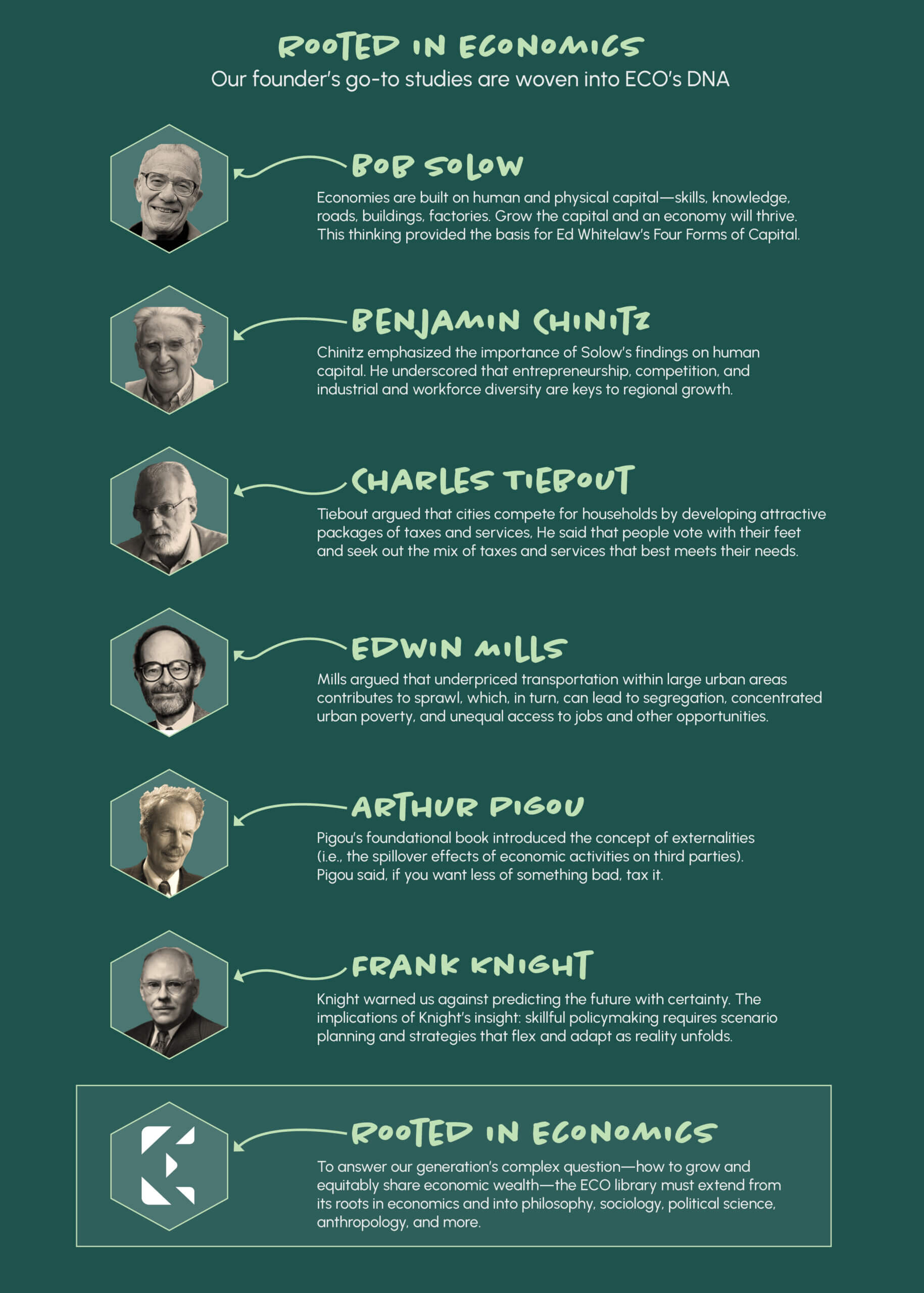February 8, 2024
Author
Our Founder’s Go-To Studies are Woven into ECO’s DNA

Fifty years ago, Professor Ed Whitelaw founded ECOnorthwest (ECO) to close a gap between academia and public policy. Ed was a knowledge hoarder and had a lot to share. Hundreds of articles and books were piled on his shelves, desks, chairs, and floor. Policymakers could learn from all of them, but he saw six of them as critical. He cited them more than others and insisted that his analysts be able to apply their insights in reports and testimony. When it came time to hire, top candidates were quizzed on Solow (1956), Chinitz (1961), Tiebout (1956), Mills (1972), Pigou (1920), and Knight (1921). Ed was an urban economist, and these works unlocked the mysteries of growing, and operating in, a regional economy.
Insights from these six economists are decades old, but they’ve stood the test of time. We find them in ECO reports and presentations all the time. Like much of the economics literature, these works are more instructive on how to efficiently grow an economy—increase the size of the pie—than how to distribute the gains. Today, our clients are focused on shared prosperity—much more than communities were in the times of Pigou and Knight.
To answer our generation’s much more complex question of how to grow and equitably share economic wealth, the ECO library must extend from its roots in economics and into philosophy, sociology, political science, anthropology, and more.
Ed, an equity-minded knowledge hoarder, would love the expansion.
Bob Solow was Ed’s professor and mentor at MIT, and Solow’s A Contribution to the Theory of Economic Growth earned him a Nobel Prize. A key takeaway: economies are built on human and physical capital—skills, knowledge, roads, buildings, factories. Grow the capital—through investment, training, and technological innovation—and an economy will thrive. Ed adapted Solow’s framework and popularized the idea of two additional forms of capital: natural (resources, amenities) and social (networks, relationships). And along with Solow’s investment, innovation, and training prescription, Ed argued that sustainable resource stewardship and community building were keys to an economy’s success.
Benjamin Chinitz emphasized the importance of Solow’s findings on human capital. In Contrasts in Agglomeration: New York and Pittsburgh, Chinitz compared the economic resiliency of the two regions. Pittsburgh was located close to massive coal reserves and exploited that proximity to fuel its steel production. The steel industry was dominated by a few firms with highly specialized workers. By contrast, New York was home to numerous industries and a lot of small businesses. When economic downturns hit, specialized Pittsburgh suffered and New York, with its highly diversified talent and industrial base, proved resilient. Chinitz underscored that entrepreneurship, competition, and industrial and workforce diversity are keys to regional growth.
Charles Tiebout was another player in this mid-century age of discovery. In A Pure Theory of Local Expenditures, Tiebout argued that cities compete for households by developing attractive packages of taxes and services. Once those packages are established, people vote with their feet and seek out the mix of taxes and services that best meets their needs. The Portland metropolitan region, which straddles two states with highly dissimilar tax regimes, has tested Tiebout’s hypothesis for decades.
Edwin Mills’ Urban Economics is currently in its 15th printing and ECO’s library holds several editions. Mills considered cities one of humankind’s most important inventions, and his seminal 1972 textbook explored how urban systems worked—and why some thrived and others didn’t. One of Mills’ insights was that the size of urban areas is heavily influenced by the cost of moving around, and underpriced transportation contributes to suburbanization which, in turn, can lead to segregation, concentrated urban poverty, and unequal access to jobs and other opportunities.
Mills contended that pricing transportation appropriately, specifically by charging drivers for the roadway congestion they create, would foster right-sized, socially integrated regions. Mills’ congestion-pricing concept had its origins in Arthur Pigou’s The Economics of Welfare—a foundational book that introduced the concept of externalities (i.e., the spillover effects of economic activities on third parties). Pigou said, if you want less of something bad, tax it. Over the years, ECO has conducted dozens of studies on so-called Pigouvian taxes aimed to reduce highway congestion, carbon emissions, alcohol use, and more.
Lastly, Frank Knight’s Risk, Uncertainty, and Profit offered lessons for elected and business leaders alike. Knight distinguished between future events where probabilities of different outcomes could be measured (risky situations) and those for which there was too little information to set the odds (uncertain situations). Labor economists can estimate AI’s impact on jobs in 2028 But will generative AI destroy humanity before ECO’s 100th anniversary? Who knows? The implications of Knight’s insight: policymakers have limited ability to predict the future, and skillful policymaking requires scenario planning and strategies that flex and adapt as reality unfolds.

